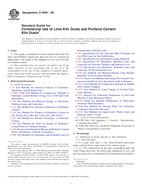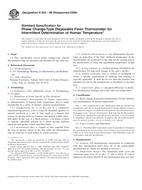1.1 This test method covers the laboratory determination of the linear (one-dimensional) coefficient of thermal expansion of rock using bonded electric resistance strain gauges.
1.2 This test method is applicable for unconfined pressure conditions over the temperature range from 20 to 260°C (68 to 500°F).
Note 1 – Unconfined tests performed at elevated temperatures may alter the mineralogy or grain structure of the test specimen. This alteration may change the physical and thermal properties of the test specimen.
Note 2 – The strain gauges are mounted with epoxy. Most commercially available high temperature epoxies require elevated temperature curing. The elevated temperature required for this curing may alter the physical and thermal properties of the test specimen. Epoxy should be selected based upon the maximum expected test temperature. Room temperature curing epoxy should be used whenever possible.
1.3 The test specimens may be either saturated or dry. If saturated specimens are used, then the test temperature shall be at least 10°C (18°F) less than the boiling point of the saturating fluid in order to minimize the effects of evaporation of the fluid.
Note 3 – When testing a saturated specimen, the moisture content of the specimen may change unless special precautions are taken to encapsulate the test specimen. Refer to 7.4.
1.4 For satisfactory results in conformance with this test method, the principles governing the size, construction, and use of the apparatus described in this test method should be followed. If the results are to be reported as having been obtained by this test method, then all pertinent requirements prescribed in this test method shall be met.
1.5 It is not practicable in a test method of this type to aim to establish details of construction and procedure to cover all contingencies that might offer difficulties to a person without technical knowledge concerning the theory of heat flow, temperature measurement, and general testing practices. Standardization of this test method does not reduce the need for such technical knowledge. It is recognized also that it would be unwise, because of the standardization of this test method, to resist in any way the further development of improved or new methods or procedures by research workers.
1.6 The values stated in SI units are to be regarded as the standard. The values given in parentheses are mathematical conversions to inch-pound units that are provided for information only and are not considered standard.
1.7 All observed and calculated values shall conform to the guidelines for significant digits and rounding established in Practice D 6026.
1.7.1 The method used to specifiy how data are collected, calculated, or recorded in this standard is not directly related to the accuracy to which the data can be applied in design or other uses, or both. How one applies the results obtained using this standard is beyond its scope.
1.8 This standard does not purport to address all of the safety concerns, if any, associated with its use. It is the responsibility of the user of this standard to establish appropriate safety and health practices and determine the applicability of regulatory requirements prior to use.
Product Details
- Published:
- 07/01/2008
- Number of Pages:
- 5
- File Size:
- 1 file , 95 KB
- Redline File Size:
- 2 files , 180 KB


